Best PC Gaming Handhelds 2024: Windows and Steam Decks
Our tested picks for the best gaming handhelds for gamers on the go.
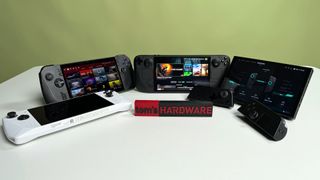
Portable gaming is nothing new. We've been through the Game Boy, the Game Gear, PS Vita, the Nintendo DS, Switch, and many more. But more recently, the idea of portable PC gaming has taken off, letting gamers take their libraries on the road with all of the tweaking and settings that playing on your own rig has to offer. The category was popularized by Valve's Steam Deck, and followed quickly by other big PC names like Asus, Lenovo, and MSI.
In order to help you find the best gaming handheld, we thoroughly tested the most popular models, benchmarking them with popular video games like Forza Horizon 5 and Cyberpunk 2077, checking to see how long their batteries last on a charge, measuring screen brightness and color gamut, and simply playing a bunch of games to see how the devices feel in our hands. We also consider price, budget, and operating system to help you determine the best bang for your buck. The best models we’ve tested are below, but if these options don’t work for you, you might want to check out our Steam Deck Alternatives feature.
There are several exciting gaming handhelds coming out that we hope to test soon, including the Zotac Zone, Acer Nitro Blaze 7, and MSI Claw 8 AI+ (the first with Intel's Lunar Lake inside).
Quick List
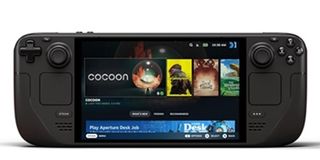
Best PC gaming handheld for most people
The Steam Deck OLED combines price and performance, starting at $549 on Steam for a portable SteamOS-based handheld with a beautiful screen. It may not be as powerful as some of the AMD Ryzen Z1 Extreme-based options, but you get great ergonomics and plenty of improvements over the original Steam Deck. If most of your PC gaming library is on Steam, this is the one to get.
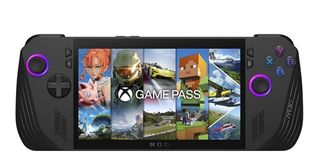
Best Windows PC Gaming Handheld
You'll pay a lot for it at $799.99, but the ROG Ally X is the best Windows experience on a handheld. It feels great in the hands, and with 24GB of RAM, the integrated Radeon GPU has more memory to play with. The screen, while not OLED, is bright and colorful, and its battery is twice as big as the original Ally.
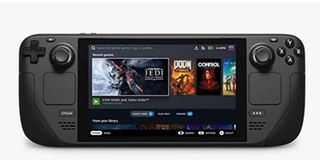
Best budget PC gaming handheld
The original Steam Deck, with an LCD screen, is your cheapest way into gaming handhelds. You still get great build quality and similar performance to the newer model, but you get an LCD screen that tops out at 60 Hz and a little less battery life. Valve sells them on Steam.
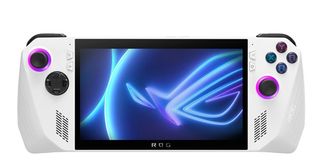
Budget Windows PC gaming handheld
If you can't shell out the ROG Ally X's price tag, the original ROG Ally gets you the same chip (on the Z1 Extreme version) and display as the newer Ally X. It isn't as ergonomically friendly and feels cheaper, though. Avoid the Z1 version if you can — the performance won't be as good.
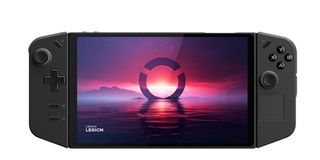
Switch-style PC gaming handheld
The Lenovo Legion Go is premium in many ways, with a luxurious screen, multiple USB-C ports, a sturdy kickstand and detachable controllers. But the 2560 x 1600 resolution doesn't make much sense for most games on the AMD Z1 Extreme, and the 8.8-inch size and Nintendo Switch-style controllers make for a bulky system that doesn't feel incredibly portable.
Best PC Gaming Handhelds 2024
Why you can trust Tom's Hardware
Best PC gaming handheld for most people
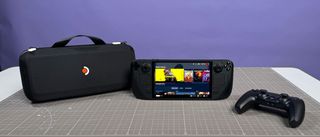
Specifications
Reasons to buy
Reasons to avoid
For many gamers, the Steam Deck OLED will hit a price/performance sweet spot. It starts at $549 with 512GB of storage or $649 for 1TB of storage on Steam. Either way, you get a 1280 x 800 OLED HDR display with up to 90 Hz refresh rate and a 50 WHr battery (slightly bigger than the original Steam Deck).
At 7.4-inches, you get a slightly larger screen than on the original Steam Deck, and you also get a boost from Wi-Fi 5 to Wi-Fi 6E. Performance is similar, though. You get the same chip specs, but on a 6 nm process.
And Valve even managed to make the Steam Deck OLED lighter than the original.
The Steam Deck OLED runs SteamOS, based on Arch Linux, and emulates Windows games. Not everything runs, but what does works pretty well (and you can install Windows on Steam Deck, if you want.) But it's also extremely easy to work with a controller, which you can't say about Windows these days.
Read: Steam Deck OLED review
Best Windows PC gaming handheld
Specifications
Reasons to buy
Reasons to avoid
If you want to run Windows on a gaming handheld, the Asus ROG Ally X is your best option. Just be ready to pay for it. The Ally X is a cool $799.
For that money, you get AMD's Z1 Extreme chip, but with 24GB of RAM, which means memory to serve the RDNA 3-based integrated graphics. The 1080p display is bright and colorful, even if it's not OLED. (1080p is plenty for this screen size. In testing, I ran plenty of games closer to 720p).
Asus upped the comfort over its original Ally with the Ally X, offering more tactile buttons, better build quality, and cooler operation.
Windows 11 runs more games than SteamOS — you can install any launcher you want. But it also isn't custom built for a small screen and a controller, and it shows. Asus' software, Armoury Crate SE, helps you launch games and set quick adjustments, but it still has some bugs to work out, too.
Read: Asus ROG Ally X review
Best budget PC gaming handheld

Specifications
Reasons to buy
Reasons to avoid
The original Steam Deck may not have been the first handheld gaming PC, but it definitely popularized the category. For those looking to get into the fun on a budget, it's still your best choice. While Valve is prioritizing the OLED model these days, it still sells the 256GB LCD version for $399 on Steam, with a 1280 x 800 display, up to 60 Hz refresh rate, and a 40 WHr battery that it claims lasts between 2 and 8 hours depending on the game.
It's comfortable to hold, and the controls feel excellent. SteamOS is far easier to use than Windows to launch games (as long as they're on Steam), and you get a similar chip to the one in the Steam Deck OLED, with the same specs, just on a different process node that's slightly less efficient. The 1280 x 800 resolution should be plenty on a 7-inch display (and some games won't run at 1080p anyway). Esports might not look as good at 60 Hz as on the OLED or some Windows machines, but lower refresh rates help the system last longer.
While supplies last, Valve is still selling the 64GB Steam Deck for $349, which is even cheaper, though you don't get an M.2 SSD, but rather eMMC storage. If you get that one, consider upgrading it on your own.
Read: Steam Deck review
Other PC gaming handhelds we tested
We also tested a few other gaming handhelds which didn't make the grade as the best.
Budget Windows PC gaming handheld

Specifications
Reasons to buy
Reasons to avoid
The Asus ROG Ally has a bright screen and is lightweight, but suffered from short battery life and wasn't as ergonomically sound as the Steam Deck. To get its best performance on the Z1 Extreme model we tested, it needed to be plugged in.
$649.99 for the Z1 Extreme version isn't usually what we consider budget, but compared to the Ally X and Lenovo Legion Go, it's the closest you'll get on Windows. It is your cheapest Windows option, at the moment, though the real value choice, the $499.99 Z1 (non-extreme) version is a poor performer.
Read: Asus ROG Ally review
Switch-style PC gaming handheld

Specifications
Reasons to buy
Reasons to avoid
The Lenovo Legion Go has a massive 8.8-inch display, a sturdy kickstand, and detachable controllers, the latter two taking clear inspiration from the Nintendo Switch. But it's too bulky to comfortably travel with, we saw performance falter on battery, and the 2560 x 1600 resolution really isn't useful for most games on the AMD Z1 Extreme. One of the detachable controllers can do double-duty as a mouse for strategy games and shooters.
It's pricey, starting at $699.99 for 512GB and $749.99 for 1TB, but it does offer unique features that the Steam Deck and other Windows handhelds don't (including a 144 Hz refresh rate, if you're willing to push it that far). And unlike the Ally and Ally X, it comes with a carrying case.
Read: Lenovo Legion Go review
How we test PC gaming handhelds
How we test PC gaming handhelds
Each gaming handheld we review goes through a series of tests and benchmarks to determine if it's worth your hard-earned money.
Currently, games that we run and may include in our reviews are:
| Game | Preset | Header Cell - Column 2 |
|---|---|---|
| Cyberpunk 2077 | Steam Deck | Row 0 - Cell 2 |
| Borderlands 3 | Medium | Row 1 - Cell 2 |
| Forza Horizon 5 | High, no anti-aliasing | Row 2 - Cell 2 |
| Red Dead Redemption 2 | Lowest (Favor Performance) | Row 3 - Cell 2 |
| Shadow of the Tomb Raider | Medium | Row 4 - Cell 2 |
| Civilization VI: Gathering Storm - Graphics Test | Ultra | Row 5 - Cell 2 |
That being said, our reviewers play games of their choice on gaming handhelds, and may mention those, too.
We also run a stress test, which currently consists of the Metro Exodus benchmark on the low preset, run 15 times in a loop while recording system statistics with HWInfo. (This is also when we take our heat tests). For productivity, we use Geekbnech for single-core and multi-core performance.
We measure gaming handheld displays with our colorimeter and light meter, and report brightness in nits, as well as the volume of the DCI-P3 and sRGB color gamut that the screen covers.
Our battery test connects to a local web server over Wi-Fi, and continuously browses the web, runs simple OpenGL graphics tests, and streams videos. We report the amount of time the laptop ran the test in hours and minutes. However, because most people will be using the best gaming handhelds to play video games, we do anecdotal testing to see how the battery fares in real life.
We also spend significant periods of time using gaming handhelds to evaluate the displays, gaming performance, included software, and how they feel to use.
Additionally, we open gaming handhelds to determine which parts are user-replaceable, so that buyers can see what they are able to upgrade and repair down the line.
PC gaming handheld shopping tips
PC gaming handheld shopping tips
🎮 Displays only need to go so far: High resolutions and fast displays are nice on paper, but it's also a big draw on a battery. Considering that you'll play most games at 720p, don't be drawn to numbers above 1080p unless you plan on using this as a secondary computer.
🎮 Battery life will be limited: A mix of big screens, high-power chips, and intensive games means you're only getting a few hours of play, maximum.
🎮 Consider where you play games: If you just use Steam for PC gaming, the Steam Deck will make a ton of sense. But if most of your catalog is on Epic Games or GOG, you may want to start looking into Windows devices.
🎮 Plug and play performance: While the Steam Deck gives you consistent performance plugged in and on-the-go, Windows handhelds perform better while they're plugged in, similar to the best gaming laptops.
Stay On the Cutting Edge: Get the Tom's Hardware Newsletter
Get Tom's Hardware's best news and in-depth reviews, straight to your inbox.
Andrew E. Freedman is a senior editor at Tom's Hardware focusing on laptops, desktops and gaming. He also keeps up with the latest news. A lover of all things gaming and tech, his previous work has shown up in Tom's Guide, Laptop Mag, Kotaku, PCMag and Complex, among others. Follow him on Threads @FreedmanAE and Mastodon @FreedmanAE.mastodon.social.
